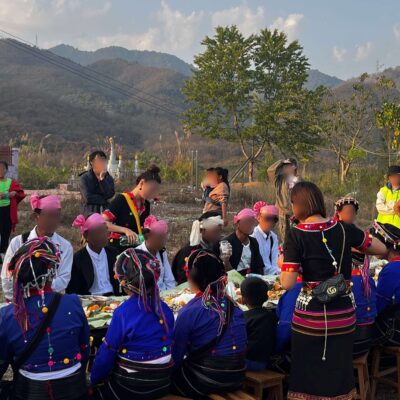Many have begun to ask whether China will step up to fill the global governance deficit caused by the withdrawal of the US from many key international agreements and other areas, especially since the beginning of the second administration of US President Donald Trump.
In the last two decades, China has evolved into a key player in global development. This significant transformation would not have been possible without the support of the United Nations Development Program (UNDP) in China. How did the UNDP shape China’s global role and help facilitate China’s transformation from an aid recipient to a provider?
China’s transformation
My career with the UNDP began in 2009, a year after the Global Financial Crisis and the grandeur of the Beijing Summer Olympics. Around this time, traditional bilateral donors such as the Canadian International Development Agency and the UK Department for International Development began scaling down their aid to China. This shift posed significant challenges for UNDP China’s funding, which relied heavily on unearmarked regular resources (core resources), and implementation service charges derived from earmarked contributions by bilateral donors for specific themes, programs, or projects.
As China steadily climbed the Human Development Index and surpassed Japan as the world’s second-largest economy in 2010, both funding streams saw a marked decline. In response, the UN system, particularly UNDP, which intended to mobilize more financing for development from China to cover the void created by the withdrawal of international funders, was expected to reposition itself to assist China’s transition from an aid recipient to a donor country.
China’s rapid rise prompted UNDP to explore innovative models of collaboration to sustain program impact while ensuring financial stability. Triangular cooperation, more commonly referred to as South-South Cooperation, emerged as a promising strategy. Under this approach, UNDP leveraged its development expertise alongside China’s technical and financial resources to address sustainable development challenges in other developing countries.
China’s rise as a global economic and political actor heightened its ambition to take on a more prominent role in global governance. Eager to be a rule maker in the global order rather than a rule follower, China increasingly challenged existing rules, norms, and procedures in the global arena. As China tried to export a development model under an authoritarian system, tensions inevitably arose. To mitigate these challenges, reduce political concerns and facilitate its global engagement, China required a neutral platform to share its development experiences and expand its influence across the Global South.
With a presence in over 170 countries and territories, UNDP presented itself as an ideal partner for China. It provided a credible platform to foster South-South cooperation, enabling China to deepen its connections with other developing economies and expand its role as a leading force in global development.
The evolving dynamics of the UNDP China development cooperation partnership created a new nexus. China widened its focus from addressing its own domestic social and environmental challenges to sharing its development model with other countries while expanding its influence within the global order. Simultaneously, UNDP shifted from its traditional role as a donor or implementing partner for bilateral and multilateral aid programs in China to that of a strategic development partner.
Establishing the legal framework
A robust legal framework to redefine the development partnership between UNDP and China was needed. In 2010, UNDP Administrator Helen Clark (former Prime Minister of New Zealand) and Chinese Premier Wen Jiabao signed a Strengthened Partnership Agreement. The agreement ushered in a new era for UNDP China, transitioning its focus to engaging with China as an increasingly influential global actor. It distinguished UNDP from other bilateral and multilateral development partners by establishing the first formal legal framework to guide a new era of development cooperation focused on China’s expanding global role.
The agreement identified five key areas for the revitalized partnership: trilateral cooperation between UNDP, China, and other developing countries; experience-sharing on foreign aid systems to assist China in redefining its foreign aid mechanisms; addressing global and regional issues, through G20, BRICS, ASEAN or FOCAC platforms where China is a key member; private sector engagement and South-South cooperation; and sharing development experiences through South-South platforms.
UNDP’s role in shaping a global China
Framing China’s role in the UN’s Sustainable Development agenda
UNDP established the ‘China in the World Theme Group’ which served as a forum for exchanging views on China’s evolving global role. The Group regularly convenes bilateral and multilateral donors, Global South countries, think tanks, and other stakeholders to foster dialogue and collaboration.
In 2012, the UNDP Administrator met with the Chinese Premier for a second time, deepening the partnership by intentionally elevating China’s role in the global development agenda. UNDP prioritized strengthening South-South Cooperation and facilitating the sharing of China’s domestic development experiences to developing countries. China’s achievements in domestic poverty alleviation were particularly underscored.
This moment occurred during a pivotal period when the global community was concluding the Millennium Development Goals (MDGs) while formulating the post-MDGs agenda. It also served as a precursor to China’s significant role in shaping the UN Sustainable Development Agenda in 2015 and reflected UNDP’s formal commitment to supporting China’s rise as a global leader in development.
Following China’s announcement of the Belt and Road Initiative in 2013, UNDP intensified efforts to align the UN’s development agenda with China’s priorities. Framing China as the world’s most populous country, the second-largest economy, and a powerful engine of global growth and trade, UNDP positioned China as a pivotal contributor to the evolution of the global development agenda.
In 2015, UNDP published a policy paper highlighting the synergies between the Belt and road Initiative and the Sustainable Development Goals (SDGs) (Scoping Paper 1). The paper argued that the BRI could accelerate the SDGs, and the SDGs could enhance the BRI’s credibility by emphasizing economic, social and environmental sustainability. This represented a significant step by UNDP in addressing global skepticism about the BRI and reinforcing China’s recognition as a key actor in international development cooperation. By demonstrating the complementarities between the BRI and the SDGs, UNDP facilitated greater integration of China’s development initiatives with the broader UN development framework.
Refining China’s aid architecture
As China transitioned from an aid recipient to an aid provider, aid-related departments of the Ministry of Commerce (MOFCOM) have faced contrasting challenges. The Department of Foreign Aid has seen a significant increase in workload due to growing overseas commitments, while the Department of International Trade and Economic Affairs has had to address gaps left by diminished inbound aid.
Recognizing UNDP’s politically neutral stance and technical expertise, both Departments approached UNDP to advise on how to best address these challenges. In 2015, following China’s pledge of USD 2 billion to a South-South Cooperation Assistance Fund (the Fund), the Department of Foreign Aid tasked the China International Center for Technical and Economic Exchange with managing the Fund. To support this, UNDP helped the China International Centre develop the Fund’s Charter, including fundamental rules, regulations, and fund management structures.
To further operationalize the Fund, UNDP deployed an experienced staff member to the China International Centre and adapted its program implementation models to China’s needs. This collaboration positioned UNDP as both an implementing partner and technical advisor. A Chinese government AidData web page and UNDP’s brochure on disaster management showcased this partnership.
Meanwhile, dwindling inbound aid prompted the Department of International Trade and Economic Affairs to explore new opportunities to maintain its work in trilateral cooperation. The Department sought to promote China’s development success stories and best practices through UNDP’s global platform. These efforts were demonstrated by Department-convened research which resulted in a book: Our Common Goal: International Experience in Poverty Reduction.
Before 2018, the management of China’s foreign aid was fragmented, with several ministries, including the Ministry of Foreign Affairs, operating under a State Council working group. As China increased its foreign aid spending and focused on aid quality and effectiveness, the limitations of this system, such as fragmented aid management in different ministry departments, became increasingly apparent.
At the Ministry of Commerce’s request, UNDP conducted research on the aid management systems of other countries, such as Brazil, India, Japan, the United Arab Emirates, the United Kingdom, and the United States, to provide recommendations to improve China’s aid governance. UNDP then proposed measures to consolidate China’s aid functions, enhance strategic planning, and improve coordination and effectiveness.
In response, China undertook a long-anticipated reform of its aid system. In April 2018, the China International Development Cooperation Agency (the Agency) was established following the resolution of overlapping responsibilities with other ministries. The Agency’s creation marked a significant milestone in China’s journey as an emerging donor.
Policy-oriented research
As China increasingly opened up to international collaboration and sought advice to reform its foreign aid system, it identified UNDP as a trusted partner for generating knowledge and providing evidence-based recommendations. Through a series of research initiatives, UNDP played a pivotal role in supporting China’s efforts to enhance its aid policies and practices:
- In 2011, at the request of the Ministry of Commerce, UNDP supported China in the G20 Development Working Group by preparing a policy paper outlining how China could position itself as a key contributor to global development dialogues and policymaking.
- In 2012, UNDP conducted research on the experiences of selected countries which had involved civil society organizations and think tanks in their foreign aid delivery. This resulted in two research papers commissioned by the China Academy of International Trade and Economic Cooperation, a think tank under the Ministry of Commerce, which offered actionable recommendations for integrating civil society organisations into China’s aid architecture.
- In 2013, the UNDP commissioned a study to explore the role of civil society organisations in South-South Cooperation The findings from these studies reinforced China’s confidence in UNDP’s expertise and strengthened the partnership.
- By 2014, UNDP’s growing credibility as a research partner was evident when the Ministry of Commerce invited UNDP to provide input to China’s Second Foreign Aid White Paper.
- In 2015, UNDP collaborated with the China Academy think tank and the State-owned Assets Supervision and Administration Commission to examine the sustainability performance of over 250 Chinese firms operating overseas. The research provided recommendations to help ensure that Chinese firms in developing countries contribute positively to local communities and align with global sustainability standards.
These policy-oriented research initiatives not only informed China’s foreign aid reform but also enhanced mutual trust between China and UNDP.
Capacity building for aid staff
As China’s international aid provision developed, it recognized a gap in professional expertise among its staff. To address this, the UNDP China assisted China to increase its representation in international organizations and facilitated staff exchanges with UNDP.
In 2013, UNDP headquarters hosted two senior officials seconded by the Department of Foreign Aid for six months, so they could gain insights into UNDP’s aid policies and practices. This was followed by the secondment of three division and deputy division directors from the Department of Foreign Aid to UNDP regional offices in Bangladesh, Zambia, and the UNDP headquarters in New York. This helped Chinese aid staff understand development practices and exposed them to the UNDP’s work practices in diverse contexts. Simultaneously, UNDP China hosted a seconded official from the Ministry of Foreign Affairs, who was later appointed as a UNDP Resident Coordinator in a Shanghai Cooperation Organization member As China’s aid international aid provision developed state, reflecting the success of these exchanges in cultivating talent for international development leadership.
Pilot projects for trilateral cooperation
Trilateral cooperation between UNDP and China has emerged as a mutually beneficial model, offering advantages to both parties. For China, working through UNDP’s politically neutral channels enhances its international image and mitigates risks associated with development projects in other countries. For UNDP, these partnerships provide an opportunity to apply best practices, technical expertise, and innovative solutions while advancing sustainable development in recipient countries.
A notable initiative was a trilateral renewable energy project involving UNDP and China’s Ministry of Science and Technology in Zambia and Ghana. The project focused on the demonstration of Chinese renewable energy technologies, tailored to local needs, and provided related critical skills training for rural communities. This partnership addressed energy poverty while showcasing China’s technological contributions in the Global South.
Another example of trilateral cooperation was a cassava project in Cambodia, which combined capacity building on cassava cultivation, yield improvement, and trade enhancement. The project promoted economic growth that benefitted the poor, by introducing technical expertise from China and establishing direct linkages with the Chinese market.
With financial backing from the UK Department for International Development, UNDP implemented a trilateral project with China, Bangladesh, and Nepal, focusing on community-based disaster management, supporting resilience building via knowledge sharing and mutual learning between China and other Asian countries threatened by natural disasters. The project was recognized as a best practice in China’s 2021 White Paper on International Development Cooperation in the New Era.
What’s next?
Trilateral cooperation with China represents a promising growth area for UNDP in light of the withdrawal of many bilateral and multilateral donors from China. These projects generate substantial cost recovery for UNDP as an implementing partner for China and other emerging donors, while simultaneously enabling the organization to maintain its relevance and impact. By leveraging its technical expertise and global presence, UNDP has positioned itself as a key player in fostering innovative partnerships and delivering sustainable development outcomes.
UNDP has successfully mobilized greater support and funding from China for its development mission at a time when Western bilateral aid providers are scaling back. Meanwhile, China has gained valuable aid management experience and capacity to match its ambition of becoming a global leader in development assistance.
The shifting landscape of global governance and the dramatic changes in international aid, particularly after the Trump administration froze USAID, may present new challenges for China’s aid provision and its role as a global actor. As China navigates a slowing domestic economy, will it continue to increase its efforts to fill the global aid gap? If so, what new role will UNDP play for China in these volatile times?
Writing in her personal capacity, Qing Gu currently serves as a senior program officer at the Ford Foundation, and previously held roles at UNDP China.
Image: Helen Clark and Wen Jiabao, 2009. Credit: UNDP/Flickr.




